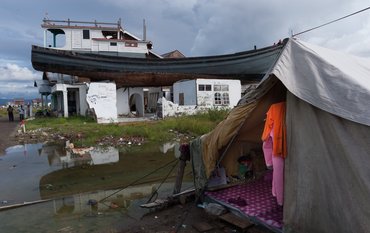The GFZ German Research Centre for Geosciences celebrated the 20th anniversary of the launch of the two GRACE satellites together with Brandenburg's Minister of Research, Manja Schüle, and the Federal Space Commissioner, Anna Christmann, as well as several members of the Bundestag. The politicians obtained first-hand information from researchers and industrial partners on the two missions GRACE (2002-2017) and GRACE-Follow On (since 2018). The tandem satellites, a joint mission of NASA, the German Aerospace Center DLR and GFZ with other research and industry partners, enabled continuous monitoring of the Earth's gravitational field for the first time – and thus also the influence that climate change has on the global water and ice balance.
On March 17, 2002, the Gravity Recovery And Climate Experiment, or GRACE for short, lifted off from the Russian spaceport in Plesetsk. The mission, consisting of two satellites flying in tandem, was the first to precisely measure the Earth's gravitational field and, in particular, its short-term changes over a long period of time. After more than tripling its nominal five-year duration, the mission ended at the end of 2017. In May 2018, its successor duo, GRACE-FO, lifted off from California to continue the time series. “What 20 years of data show us in terms of environmental changes and consequences of climate change is dramatic,” says Niels Hovius, Scientific Executive Director (interim) of GFZ, summarizing the results. “Without the two missions GRACE and GRACE-FO, we would continue to rely on estimates as far as the global water cycle is concerned.” This makes it all the more important, Hovius continues, “that we do not let the time series cease and that we launch a follow-on mission in five years at the latest.”
At an anniversary event on Potsdam's Telegrafenberg, researchers from the GFZ and its neighboring institutes – the Potsdam Institute for Climate Impact Research and the Alfred Wegener Institute for Polar and Marine Research – together with colleagues from NASA, the German Aerospace Center (DLR), two Max Planck Institutes and Airbus Defense & Space informed politicians about the missions.
Anna Christmann: "Understanding the causes and consequences of the climate crisis even better"
Anna Christmann, the Federal Government's Space Commissioner, explains: “20 years of this GRACE mission are a reason to celebrate. The data from the GRACE and GRACE-FO satellite missions provide important contributions to the modeling of the Earth system. Both missions are based on a successful and trustful cooperation between Germany and the USA. Only through the expertise and competencies of both countries is it possible to carry out unique gravity field measurements and, thus, to understand the causes and consequences of the climate crisis even better.”
Manja Schüle: "Important contribution to monitoring climate change"
Brandenburg's Minister of Research Manja Schüle joined in the congratulations, adding: “For decades, cutting-edge research in the field of Earth system research, environmental monitoring and climate modeling has been carried out at Telegrafenberg. From the GeoForschungsZentrum, but also from the Potsdam Institute for Climate Impact Research and the Alfred Wegner Institute for Polar and Marine Research – concentrated expertise working to find solutions for the global challenges of climate change. Exactly 20 years ago, the launch of the GRACE mission, in particular, also advanced this important research. The twin satellites have made an important contribution to monitoring climate change, for example by showing changes in the global water cycle, details of sea level rise and the increasingly rapid melting of polar ice.”
Importance of gravity field data for Earth system research
The most important product of GRACE and now of GRACE-FO are monthly maps of the gravity field for the entire globe. Andreas Lindenthal, head of Airbus Space Systems Germany, comments, “The differences in the Earth's gravity field measured by GRACE and GRACE-FO, respectively, provide fundamental information on the large-scale dynamics of the planet. Monitoring, for example, near-surface and subsurface water storage, as well as changes in sea level and ocean currents, provides an integrated global picture of how the Earth's energy budget is evolving - changes that have important implications for the daily lives of many people.”
Among other things, the GRACE and GRACE-FO satellites provide information on the total water content on and below the Earth's surface ("Total Water Storage," or TWS) and its spatial and temporal changes. The Global Climate Observing System of the World Meteorological Organization defined TWS as an "essential climate variable" in 2020, thus highlighting the important role that data from gravity field missions play in monitoring and describing climate change.
Airbus GRACE program manager Albert Zaglauer emphasizes, "With our highly reliable and durable GRACE and GRACE-FO satellites, Airbus has provided scientists and users with the critical measurement tools that enable global, sustainable research into the state of our planet. With our advanced satellite technology and manufacturing expertise, we also have the answers to future mission requirements today and can reliably develop and implement them."
Measuring principle of the satellite duo
The measurement principle implemented with GRACE is the only method that can observe changes in the water cycle – even far below the Earth's surface. The GRACE and GRACE-FO data made it possible for the first time to precisely quantify the loss of ice mass from the large ice sheets on Greenland and Antarctica, as well as the course of droughts. Record losses of Greenland ice in 2019 and drought years in 2018 and 2019 in Europe attracted particular attention: for example, more than 530 billion tons of ice melted in Greenland in 2019, about twice the annual average since 2002. In central Europe, the drought of recent years led to a water deficit in summer 2019 that was twice the usual summer water deficit. The mission is making a critical contribution to better understanding the Earth system. In the latest Intergovernmental Panel on Climate Change (IPCC) report, GRACE is the third most cited satellite mission.
At the anniversary event, the researchers and industry partners also provided information on the measurement principle and its further development. The two GRACE and GRACE-FO satellites continuously transmit microwave signals that are received by the other. From this, minimal distance changes in the micrometer range between the two spacecraft are derived, which in turn are caused by mass changes on Earth. From the approximately 500 orbits of the satellite tandem within a month, it is then possible to derive continuous maps of the Earth's global gravity field with a resolution of about 300 kilometers by 300 kilometers. These time series, now 20 years long, have shown how water, ice and solid material move on the Earth or beneath its surface over time. The distance measurement between the two satellites by laser interferometry (LRI for Laser Ranging Interferometer), which was tested for the first time in space on GRACE-FO, has proven its worth. The LRI is to replace the previous distance measurement by microwaves in the planned follow-up mission GRACE-I. The LRI was co-developed by the Max Planck Institute for Gravitational Physics and is to be used in a space telescope for gravitational waves.
ICARUS to fly in the future
Researchers from NASA's Jet Propulsion Laboratory (JPL), the German Aerospace Center (DLR) and the GFZ are already working on the plans for the successor mission GRACE-I together with colleagues from two Max Planck Institutes. Like its two predecessor missions, GRACE-I will break new scientific and technological ground. The I stands for the additional payload ICARUS (International Cooperation for Animal Research Using Space) – a system with which animal migrations can be tracked from space. In addition, a novel device for measuring the gravitational field, a Quantum Gravity Gradiometer QGG, is to fly on board. Like the LRI on GRACE-FO, the QGG will be tested as a technology demonstrator for subsequent gravity field missions.
Scientific contacts:
Dr. Eva Börgens
Scientist in Section 1.3 Earth System Modeling
eva.boergens@gfz-potsdam.de
+49-331-288-1140
Dr. Henryk Dobslaw
Group Leader in Section 1.3 Earth System Modeling
henryk.dobslaw@gfz-potsdam.de
+49-331-288-1974
Prof. Dr. Frank Flechtner
Head of Section 1.2 Global Geomonitoring and Gravity Field
Principal Investigator at GFZ for the GRACE and GRACE-FO Missions
frank.flechtner@gfz-potsdam.de
+49-8153-90832-10



![[Translate to English:] Begrüßung der Gäste im Café Freundlich durch Niels Hovius und Lotte Krawczyk](/fileadmin/_processed_/0/a/csm_20220317_GFZ_20JahreGrace_006_Ben-Kriemann_9b07e815b2.jpeg)








![[Translate to English:] Fire in a forest, smoke rising, aerial view from above](/fileadmin/_processed_/8/3/csm_2025_01_06_AdobeStock_415831729_5a0e6d50d3.jpeg)









![[Translate to English:] [Translate to English:] Abror Gafurov von dem Schriftzug "Welcome to Azerbaijan" und den UN und COP Logos](/fileadmin/_processed_/2/5/csm_2024_11_Baku_COP29_Abror_Gafurov_1042faec82.jpeg)


![[Translate to English:] Martin Herold standing in front of the library on the Telegrafenberg](/fileadmin/_processed_/c/d/csm_Martin_Herold_d385ee4dd9.jpeg)
![[Translate to English:] Many people are listening to a presentation in the GFZ lecture hall.](/fileadmin/_processed_/c/a/csm_1_Bild1_hell_b9c0e9f5ed.jpeg)






![[Translate to English:] Both scientists sitting on stools in front of a wall of books in the Telegrafenberg library](/fileadmin/_processed_/6/6/csm_Buiter_Castell_DORA_4_e87cb1ea18.jpeg)
![[Translate to English:] Gruppenbild mit 4 Personen](/fileadmin/_processed_/8/d/csm_20241017_GFZ-Emmerman-Medal-005_web_reinhardtundsommer_21a414fa4a.jpeg)






![[Translate to English:] Ice landscape with five red tents](/fileadmin/_processed_/8/9/csm_Zeltlager_auf_dem_Eis_Urheberin_Jenine_McCutcheon_5ced2d523b.jpeg)